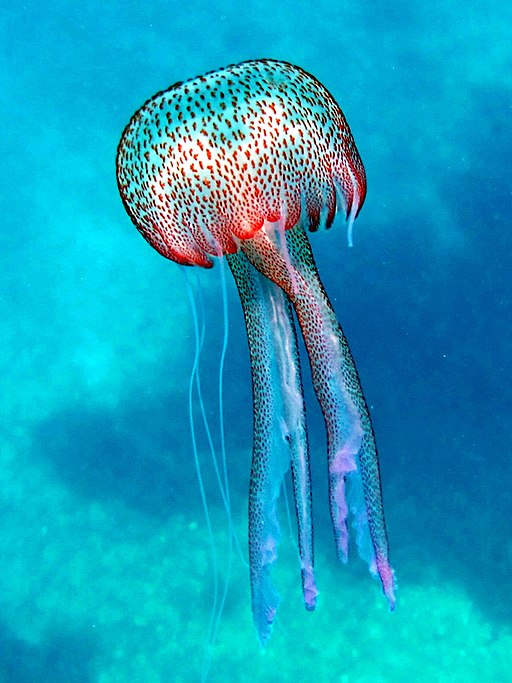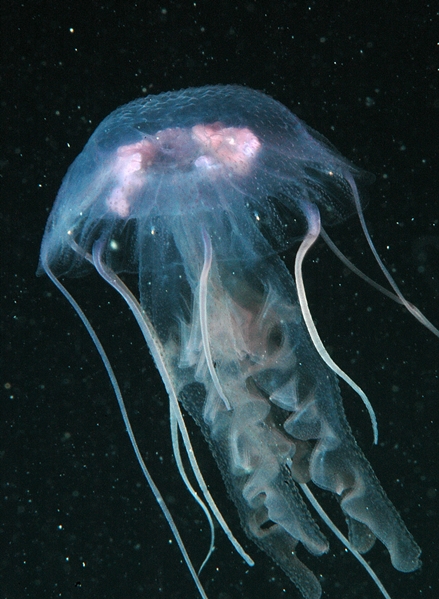
28 Jun THERE IS SOMETHING FISHY ON THE MEDITERRANEAN COAST…
Médusa – like the mythical Greek monster with snakes for hair is every swimmer’s and beach goer’s nightmare. The invader is a marine organism with no brain, made of 95% water and has the ability to shine in the dark. Not what you might call threatening, if you only had to deal with one or two.
Every summer, we are warned to watch out for jellyfish as the invasions of the stinging sea creatures are on the rise not only along Europe’s Mediterranean coast but around the world.
Pelagia Noctiluca or Mauve stinger, 10 cm fluorescent jellyfish with pink or purple tones is the most common type of jellyfish found on Côte d’Azur. The bad news is that it is one of the most stinging species of jellyfish.
Still, this should not put you off from entering the beautiful blue waters of Mediterranean Sea. Jellyfish can be avoided with extra caution and unless you are allergic, the effects of the stinging will disappear within a few days. Here is everything you need to know about how to protect yourself and not to let these sea devils spoil your day at the beach.

WHAT ARE THE WARNING SIGNS?
An orange flag on the beach (green flag means it is a jellyfish free zone)
Nobody is in the water
Kids and adults are on the paddle boards
The cleaning boat is out patrolling
WHAT TO DO IN CASE YOU GET STUNG?
Get out of the water – first of all, don’t panic! In case you have been stung, get back to the dry land as soon as possible to avoid another sting.
Rinse with sea water – Do not use cold drinking water as this will cause more poisson to be released thus more pain. Do not touch the affected area with your hands. Try to remove the visible tentacles with any object but your hands, tweezers obviously being the best but not many of us bring them to the beach. Use a credit card, postcard, knife, sharp stone…
Rinse with vinegar – Douse the affected area with vinegar, don’t rub it in.This will help to relieve the pain. Might sound bizarre but a small travel bottle of vinegar should be in your beach bag, right next to your sunscreen. Despite the popular myth, don’t use urine instead of vinegar! Urine can be effective for some fish bites but never for jellyfish.
Hot water, ice bag, freezing spray – after rinsing the area with sea water, apply hot water – as hot as you can tolerate, for 20 minutes or until pain is relieved. A hot shower should do the trick.
Otherwise apply ice, but always in a plastic bag so your skin doesn’t come in contact with it.
Both methods will help stop the venom. If you want to be extra prepared, especially if you have small children, you can buy a freezing spray in the pharmacy and bring it to the beach.
Report – if you are on the beach with a lifeguard on duty called “Secours”,head there for help. They are medically equipped and trained for situations like this, plus by reporting it you might prevent another swimmer from getting stung.
HOW CAN WE PREVENT TO GET STUNG BY JELLYFISH?
The best protection against stings is suncream, which prevents the venom from penetrating the skin.
Wear goggles or snorkeling masks while swimming as you will be able to see your surroundings better.
Never touch a jellyfish, even one that seems to be dead, as the toxins remain encapsulated in the tentacles for sometime after the jellyfish dies.
Check with the lifeguards if any jellyfish has been seen in the area that day.
Unfortunately the jellyfish nets used by many beaches on the Riviera are not entirely effective, so still swim with the caution.
Avoid areas where waves break as this is where jellyfish normally accumulate.
The Oceanographic Observatory of Villefranche sur Mer that researches and maps locations of jellyfish on the French Riviera has created an interactive website that allows you to check sightings of jellyfish in your area. Click on http://meduse.acri.fr/carte/carte.php for updated information. It is very easy to navigate, the red flag means there was an occurrence of jellyfish in the last 24 hours, orange stands for the day before yesterday and yellow for more than 2 days. Once you click on the icon of the jellyfish you find out more details, such as the date, density and type of jellyfish.
WHY DOES IT HURT?
Jellyfish never bite swimmers, they sting when you come into contact with their tentacles.
In the tentacles are the nematocysts, microscopic stingers with a toxic substance that fulfills the function of defence and captures the prey.
When we brush the tentacles, those stingers come off with toxins that cause itch, painful and burning sensation, swelling, redness and a possible slight bleeding. In most cases all the symptoms disappear within a few days.
WHAT ARE THE MAIN CAUSES OF THE SPREAD OF JELLYFISH?
In “Twenty Thousand Leagues Under the Sea”, Jules Verne described oceans emptied of their fish and “cluttered with jellyfish” . Is his prediction coming true? Why is this happening?
Global warming – warm weather has heated up the Mediterranean meaning that jellyfish reproduce and mature more quickly.
Disappearance of natural predators – such as tuna (especially bluefin tuna), swordfish and sea turtles.
Overfishing – disappearance of fish that feed on the same food as jellyfish – plankton. Plus the jellyfish eats those fish’s eggs.
Pollutant discharges of anthropic origin – estradiol, a hormone contained in contraceptive pills and drugs treating menopause are released to the ocean and causing mutations in fish. They pretty much change fish by hormonal modification into females thus interferes with their reproduction. Jellyfish, more rudimentary, asexual, are not disturbed, and take the opportunity to multiply.













No Comments